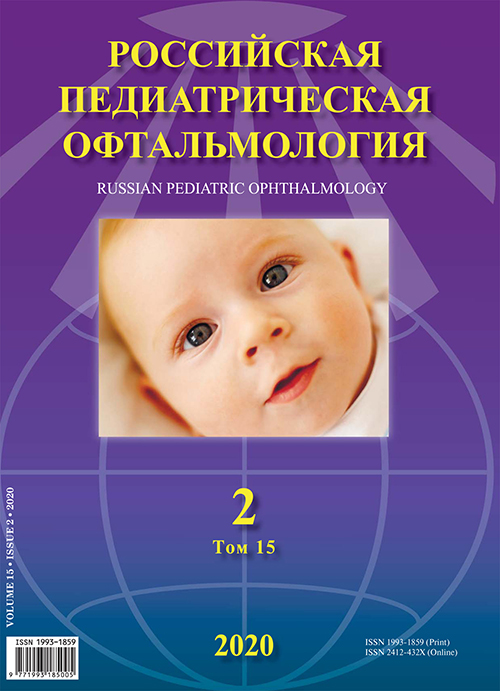Региональные факторы соматической отягощенности беременных и дородовые факторы риска ретинопатии недоношенных в Алтайском крае
- Авторы: Лебедев В.И.1
-
Учреждения:
- ФГБОУ ВО «Алтайский государственный медицинский университет» Минздрава России
- Выпуск: Том 15, № 2 (2020)
- Страницы: 5-10
- Раздел: Клинические исследования
- Статья опубликована: 15.06.2020
- URL: https://ruspoj.com/1993-1859/article/view/59394
- DOI: https://doi.org/10.17816/rpo2020-15-2-5-10
- ID: 59394
Цитировать
Полный текст
Аннотация
Несмотря на прогресс в медицине, количество преждевременных родов в результате применения новых репродуктивных технологий увеличивается. Преждевременные роды — многофакторный процесс. Успехи неонатальной реанимации в выхаживании детей с экстремально низкой массой тела при рождении приводят к увеличению количества выживших детей с различной офтальмологической патологией. Ретинопатия недоношенных остается одной из актуальных проблем детской офтальмологии, являясь одной из ведущих причин слепоты и слабовидения у преждевременно рожденных младенцев. Ретинопатия недоношенных – мультифакториальное заболевание, частота возникновения и тяжесть проявления которого обусловлены влиянием множества факторов риска, оказывающих неблагоприятное воздействие на незрелую сетчатку недоношенного ребенка и приводящих к нарушению ее нормального васкулогенеза.
Цель. Оценка состояния здоровья рожениц и взаимосвязи этого фактора с развитием ретинопатии недоношенных в Алтайском крае.
Материал и методы. Для достижения поставленной цели нами проанализированы статистические сборники демографического ежегодника Алтайского края за 11 лет (с 2005 по 2016 гг.), а также 2160 историй болезни младенцев, находившихся на лечении в Алтайской краевой клинической детской больнице за тот же период.
Результаты. Статистически значимые различия (р < 0,05) обнаружены по заболеваемости матерей гепатитом и сахарным диабетом. Наиболее выраженные различия, подтверждающие факт наличия дородовых факторов риска ретинопатии недоношенных, получены по таким параметрам, как анемия беременных, фетоплацентарная недостаточность, гестоз, пиелонефрит беременных и др.
Заключение. Выявлена значительная соматическая отягощенность рожениц в Алтайском крае, существенно превышающая по большинству параметров среднестатистические показатели в Российской Федерации. Выделены наиболее значимые антенатальные факторы риска рождения недоношенных детей к развитию ретинопатии недоношенных, что необходимо учитывать при организации профилактики раннего выявления РН в условиях Алтайского края.
Ключевые слова
Полный текст
Об авторах
Владимир Ильич Лебедев
ФГБОУ ВО «Алтайский государственный медицинский университет» Минздрава России
Автор, ответственный за переписку.
Email: sibvil@bk.ru
ассистент кафедры, заведующий отделением, главный внештатный специалист - детский офтальмолог
Россия, 656906, г. Барнаул, Российская ФедерацияСписок литературы
- Лебедев В.И. Анализ демографической ситуации и состояние перинатальной помощи детям в Алтайском крае (Сообщение 1). Российская педиатрическая офтальмология. 2017;12(2):102-6. doi: 10.18821/1993-1859-2017-12-2-102-106.
- Основные показатели здоровья матери и ребенка, деятельность службы охраны детства и родовспоможения в Российской Федерации. Статистический сборник. М.; 2018. 169 c.
- Зобова Д.А., Парамонова Т.К., Тюрина Н.А. Сахарный диабет как фактор риска преждевременных родов. В кн.: Проблемы современных интеграционных процессов и пути их решения: Сборник статей Международной научно-практической конференции. Киров; 2016. Ч.2:145-8.
- Деев И.А., Куликова К.В., Кобякова О.С., и др. Факторы риска, ассоциированные с рождением детей с массой тела менее 2500 г: результаты ретроспективного когортного многоцентрового исследования. Педиатрическая фармакология. 2016;13(6):549-53. doi: 10.15690/pf.v13i6.1667.
- Чулков B.C. Факторы сердечно-сосудистого риска, особенности течения и исходов беременности у женщин с преэклампсией и без преэклампсии на фоне хронической артериальной гипертензии. Молодой ученый. 2015;(16):97-100.
- Гималтдинова А.В. Течение беременности и родов у женщин старшей возрастной группы. Вестник Российского государственного медицинского университета. 2014;(2):20-1.
- Медведев Б.И., Сашенков С.Л., Сюндюкова Е.Г. Исходы беременности и родов у женщин с гестозом и анемией. Акушерство и гинекология. 2012;(2):24-9.
- Yi S.W, Han Y.J., Ohrr Н. Anemia before pregnancy and risk of preterm birth, low birth weight and small-for-gestational-age birth in Korean women. Eur J Clin Nutr. 2013;67(4):337-42. doi: 10.1038/ejcn.2013.12.
- Rahman M.M., Abe S.K., Rahman M.S., et al. Maternal anemia and risk of adverse birth and health outcomes in low-and middle-income countries: systematic review and meta-analysis. Am J Clin Nutr. 2016;103(2):495-504. doi: 10.3945/ajcn.l 15.107896.
- Spiegler J., Stichtenoth G., Weichert J., et al. Pregnancy risk factors for very premature delivery: what role do hypertension, obesity and diabetes play? Arch Gynecol Obstet. 2013;288(1):57-64. doi: 10.1007/s00404-013-2739-6.
- Zhang X.R., Zeng С.М., Liu J. Risk factors for preterm birth and complications in 287 late preterm infants. Zhongguo Dang Dai ErKe Za Zhi. 2011;13(3):177-80. (in Chinese)
- Witcher P.M., Chez B.F., Baird S.M. Multisystem effects of hypertensive disorders of pregnancy: a comprehensive review. J Perinat Neonatal Nurs. 2015;29(3):229-39. doi: 10.1097/JPN.0000000000000114.
- Madan J., Chen M., Goodman E., et al. Maternal obesity, gestational hypertension, and preterm delivery. J Matern Fetal Neonatal Med. 2010;23(1):82-8. doi: 10.3109/14767050903258738.
- Favilli A., Pericoli S., Acanfora M.M., et al. Pregnancy outcome in women aged 40 years or more. J Matern Fetal Neonatal Med. 2012;25(8):1260-3. doi: 10.3109/14767058.2011.643327.
- Carter M.F., Fowler S., Holden A., Xenakis E., Dudley D. The late preterm birth rate and its association with comorbidities in a population-based study. Am J Perinatol. 2011;28(9):703-7. doi: 10.1055/s-0031-1280592.
- Tunay Z.O., Ozdemir O., Acar D.E., et al. Maternal diabetes as an independent risk factor for retinopathy of prematurity in infants with birth weight of 1500 g or more. Am J Ophthalmol. 2016;168:201-6. doi: 10.1016/j.ajo.2016.05.022.
- Dai Al., Demiryurek S., Aksoy S.N., et al. Maternal iron deficiency anemia as a risk factor for the development of prematurity. Pediatr Neurol. 2015;53(2):146-50. doi: 10.1016/j.pediatrneurol.2015.04.002.
- Mohamed S., Murray J.C., Dagle J.M., Colaizy T. Hyperglycemia as a risk factor for the development of retinopathy of prematurity. BMC Pediatr. 2013;13:78. doi: 10.1186/1471-2431-13-78.
Дополнительные файлы







